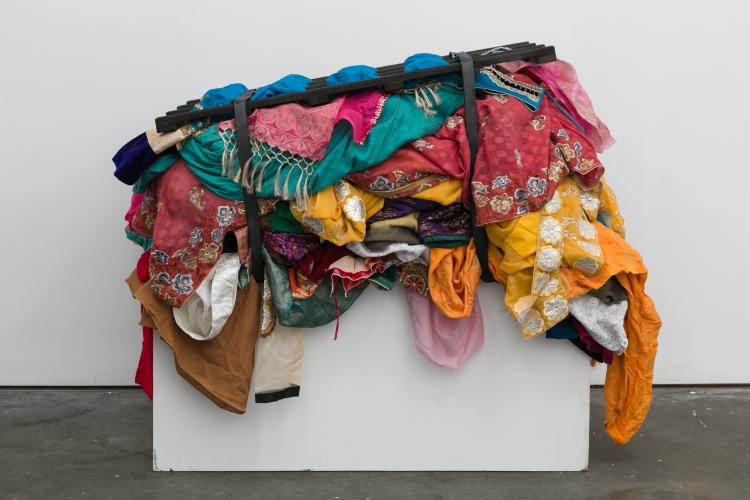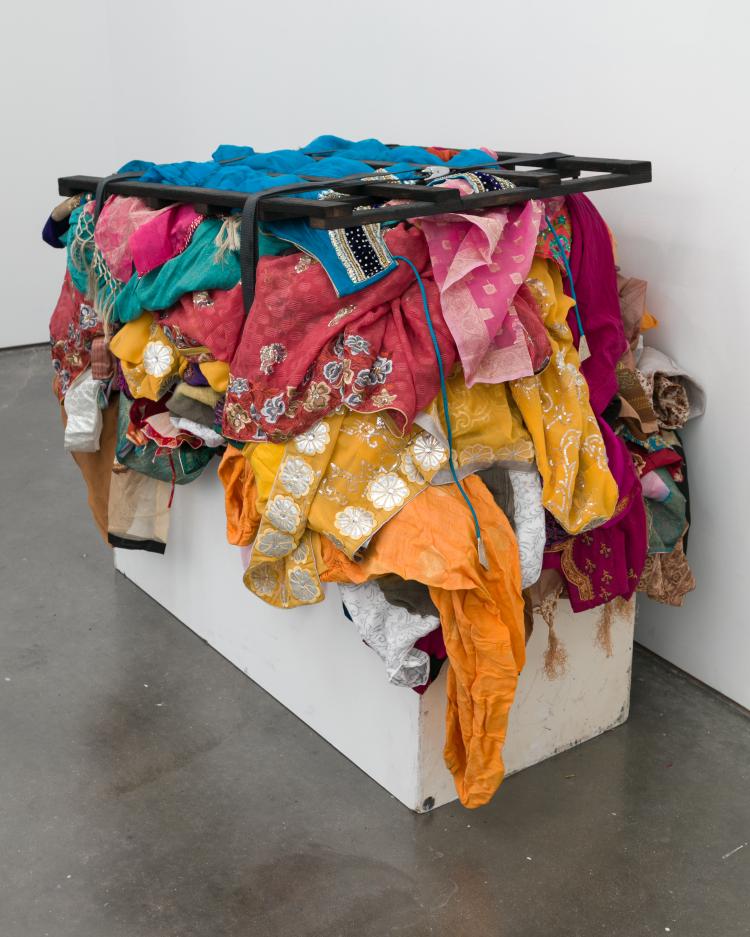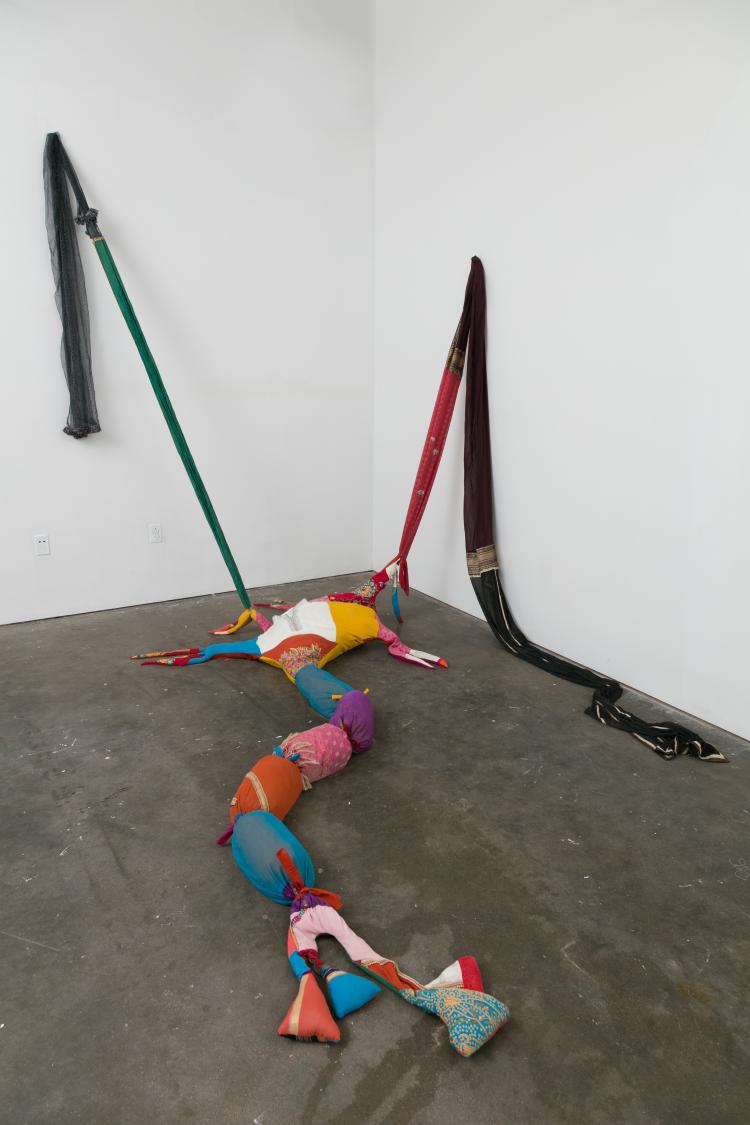Shloka Dhar

"Preserve," 2021. Indian women’s clothing, wood, nails, Yakisugi technique
Yakisugi is a Japanese wood burning technique utilized for its preservative qualities. The carbohydrate component of the wood is burned away, preventing bugs and fungi from metabolizing it. I used this technique to create a traditional plant press, used for drying specimens under pressure. Living in America has resulted in a loss of connection to my cultural heritage, and these are my efforts to preserve my fading link. I placed Indian women’s clothing in the press, to protect from bugs and other external harm. The mass of clothing threatens to burst out from one side, cascading over itself, representative of a vibrant culture that is difficult to capture. While we try to preserve things and keep them safe, we might end up suffocating or damaging those things. The squeezing of the material and the transfer of charcoal is evidence of this.

"Preserve," 2021. Indian women’s clothing, wood, nails, Yakisugi technique
Artist Statement
Shloka Coral Dhar
Displaced Kashmiri, born 1999
I was born in Bokaro Steel City, an industrial capital, but my roots are from Kashmir. It is a warzone that I have never been able to visit, and now I am a citizen of a country that I feel does not want me. I do not belong where I am now, stuck in a liminal space. My art documents my explorations through this in-betweenness, of expeditions through my personal identity and how it shapes my interactions with the physical world. My work considers the intersectionality of my identity, and is formulated by the interdisciplinary aspects of my studies. My research in Molecular Biology enables me to connect microscopic details to a larger scale, outlining my social responsibility as an artist and scientist to communicate them. Any foray into land art or the use of natural materials is aligned and immersed with issues of conservation, climate change, and environmental racism. Any crusade into my personal identity considers ideas of marginalization, assimilation, and cultural repression.
My work accesses ancestral memories, experiences, and objects and integrates them with my current reality. Their preservation is an essential bond to unreachable land and fading familial connection that has survived a genocide, but falters with time. Through my art, I craft a narrative for myself that accepts my transitional state, and still reinforces the ways in which I am still connected. Our connection to land and the human culture residing on its surface has been commodified and violated, and confronting these realities shape my current work.
Biography
Shloka Dhar is an artist pursuing a BFA in Sculpture and Post-Studio Practices, as well as a BA in Molecular, Cellular, and Developmental Biology at the University of Colorado, Boulder. She was born in India, and her work considers the preservation of her cultural identity as a result of displacement. In using traditional cultural objects to connect with ancestral memory, she rekindles her relationship with a Kashmiri heritage lost in a genocide. Her research in Molecular Biology defines the forms and processes used in her work. She hopes to continue her interdisciplinary studies to create installations that make scientific data more accessible to the public. She has shown work in multiple exhibitions on campus including Partial Totality, Recalibration, Epoch, and has won awards at the King’s Exhibition.
Instagram handle: shlokadhar
"Genetic Memory," 2021
Indian women’s clothing, thread, play sand, poly-fil
Genetic memory is the scientific theory that memories can become incorporated into the genome over time, and passed down to an offspring. Thus, memories are present at birth without any previous sensory interactions. This has been bolstered by emerging research. Transgenerational epigenetic inheritance discusses how a traumatic event in an ancestor’s lifetime can alter the brain and behavior of subsequent generations. Neurons quickly break both strands of the DNA helix in multiple locations to provide access to memory storage genes, particularly synaptic genes. In this way, ancestral memories and experiences work to protect the offspring from birth.
In this piece, I explored my genetic memory. My mother, who survived the Kashmiri Pandit genocide of 1990, still experiences PTSD from those attacks. So much of my Kashmiri heritage has been erased and lost, family heirlooms left behind to save future generations. The passing of my great-grandmother and grandmother continuously reminds me of the fading connection to my home, and the traditions and craft making that only their memory held.
Using clothing sourced from Indian women who are close to me, including my mother, I attached the pieces much like neurons attach to each other. The clothing was varied in the size and age of the woman it belonged to, with some children’s clothing as well. I created a patchwork quilt, something that has a history of being passed down generations. By filling it with play sand and stuffing, I referenced childhood memories. The form took on a single neuronal cell, attempting to form connections with other neurons that are not within reach. The dendrites reach out to receive signals from other neurons that will never come. They are turning black, undergoing degradation from their interactions with lifeless materials.

"Genetic Memory," 2021. Indian women’s clothing, thread, play sand, poly-fil

